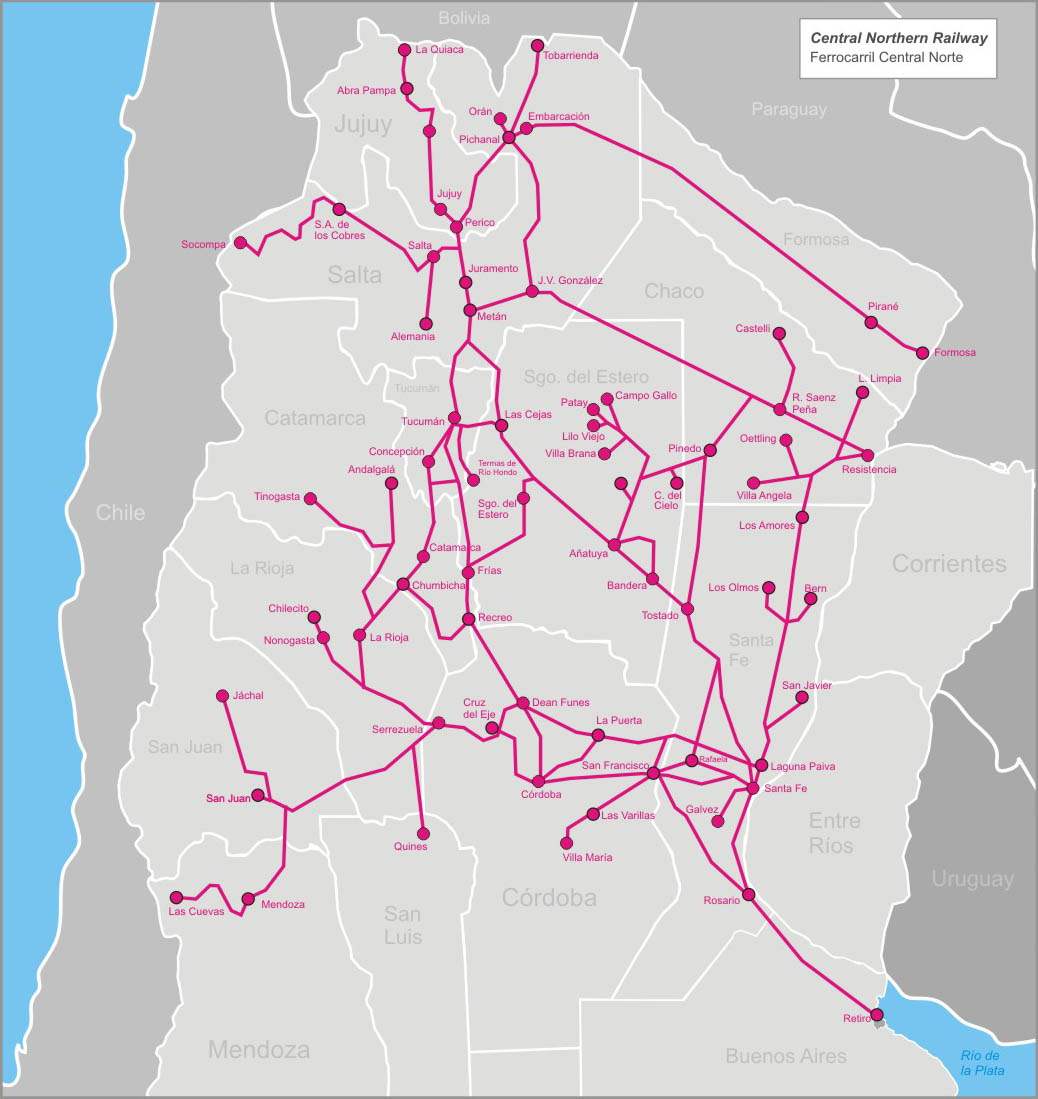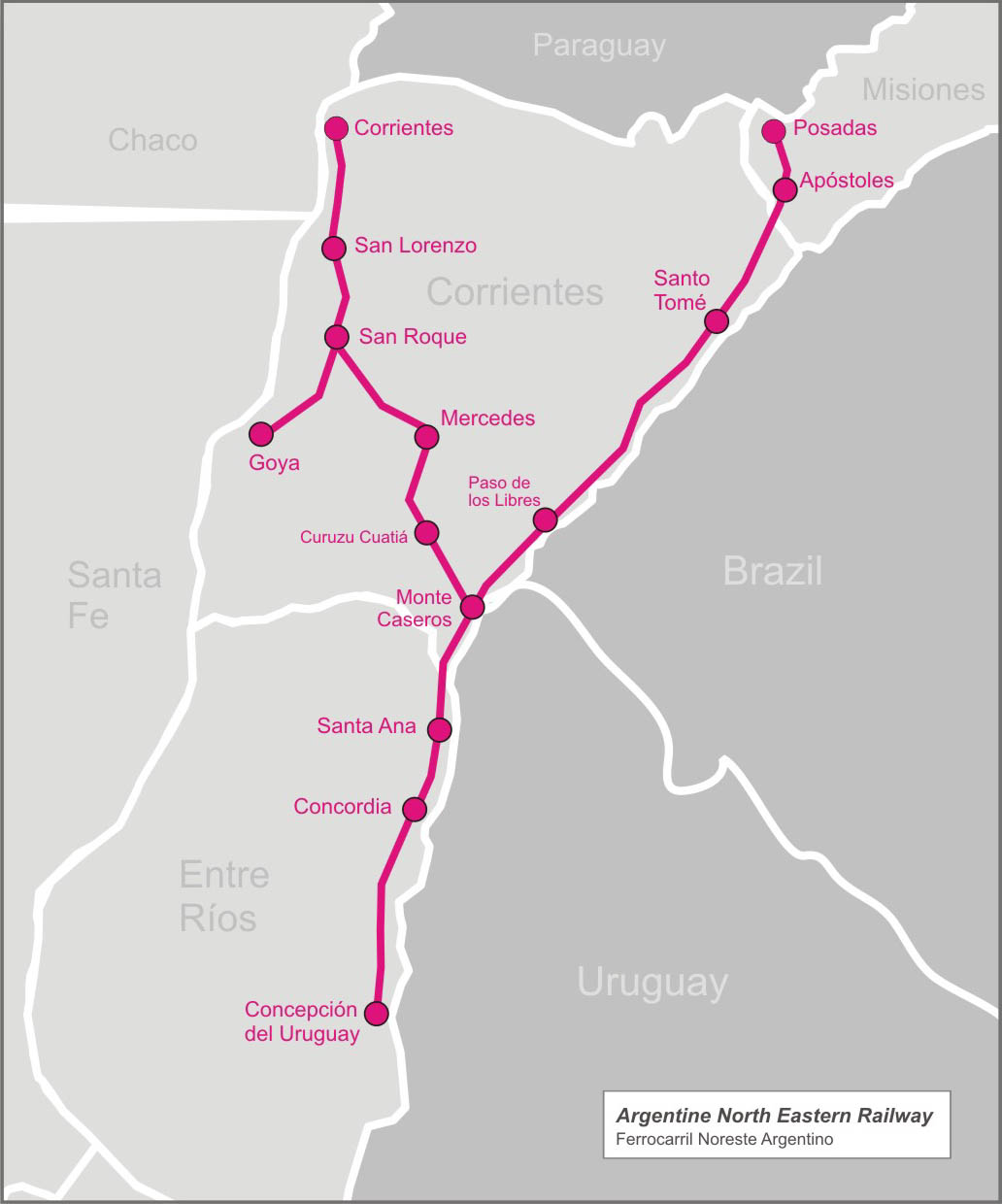|
Ferrocarril General Urquiza
The General Urquiza Railway (FCGU) (in Spanish: Ferrocarril General Urquiza), named after the Argentine general and politician Justo José de Urquiza, is a standard gauge railway of Argentina which runs approximately northwards from Buenos Aires to Posadas, with several branches in between. It was also one of the six state-owned Argentine railway companies formed after President Juan Perón's nationalisation of the railway network in 1948. The six companies were managed by Ferrocarriles Argentinos which was later broken up during the process of railway privatisation beginning in 1991 during Carlos Menem's presidency. The FCGU incorporated the British-owned Entre Ríos Railway and Argentine North Eastern Railway companies, as well as the standard gauge segments of the Argentine State Railway, and its principal lines departed from Federico Lacroze railway terminus in Buenos Aires to the north east through the provinces of Buenos Aires, Entre Ríos, Corrientes, and Misiones. To ... [...More Info...] [...Related Items...] OR: [Wikipedia] [Google] [Baidu] |
Posadas-Encarnación International Train
The Posadas–Encarnación International Train is a commuter rail international service operated between Posadas in Argentina and Encarnación in Paraguay, running on the Urquiza Railway standard gauge tracks. The service was opened in January 2014. Overview Trains are run by private company Casimiro Zbikoski S.A. under an operation agreement with State-owned Operadora Ferroviaria Sociedad del Estado (SOFSE). The train crosses the San Roque González de Santa Cruz Bridge which joins the two countries together and has an average journey time of 10 minutes with a 30-minute frequency. The current rolling stock consists of two-carriage diesel-hydraulic railcars originally called " Wadloper", built between 1981 and 1983 by German company Duewag for the Dutch railway company Nederlandse Spoorwegen, [...More Info...] [...Related Items...] OR: [Wikipedia] [Google] [Baidu] |
Ferrocarriles Argentinos
Ferrocarriles Argentinos (abbreviated as FA; ) was a state-owned company that managed the entire Argentine railway system for nearly 45 years. It was formed in 1948 when all the private railway companies were nationalised during Juan Perón's first presidential term, and transformed into the ''Empresa de Ferrocarriles del Estado Argentino'' (EFEA; ). FA managed both passenger and freight services, including long-distance and commuter rail trains in the metropolitan area of Buenos Aires. The company was broken up under the government of Carlos Menem following the privatisation of the railways; however in 2015 the government of Cristina Kirchner revived the brand for use on state-owned railways.Otro salto en la recuperación de soberanía Pagina/12, 16 April 2015. [...More Info...] [...Related Items...] OR: [Wikipedia] [Google] [Baidu] |
Concepción Del Uruguay
Concepción del Uruguay is a city in Argentina. It is located in the Entre Ríos Province, Entre Ríos province, on the western shore of the Uruguay River, some 320 kilometers north from Buenos Aires. Its population is about 80,000 inhabitants (). History The city was founded on June 25, 1783, by Tomás de Rocamora. Rich in ancient monuments, it is sometimes referred to as ''La Histórica'' ("The Historical") due to is participation in the national formation process. The ''Palacio San José'', the old personal residence of ''caudillo'' Justo José de Urquiza is located only 23 km from Concepción. Background A populated area known as Arroyo de China (which had no foundation), was recorded in approximately 1778 and located north of the namesake creek in what are now the neighborhoods of Puerto Viejo and La Concepción in the extreme south of the city. The same year the first chapel was erected at a place that would subsequently be used as a cemetery. Foundation Commiss ... [...More Info...] [...Related Items...] OR: [Wikipedia] [Google] [Baidu] |
Paraná, Entre Ríos
Paraná () is the capital city of the Argentine province Entre Ríos, located on the eastern shore of the Paraná River, opposite the city of Santa Fe, capital of the neighbouring Santa Fe Province. The city has a population of 247,863 (). History During the 16th century, inhabitants of the city of Santa Fe settled at the other shore of the Paraná river. The first settlers called it “''Baxada del Paraná''”. Between 1854 and 1861 it was the capital city of the Argentine Confederation. Economy Paraná is not only the head of the provincial government, but also an important river port for the transshipment of cereals, cattle, fish, and lumber from the surrounding region. The principal industries installed are the manufacture of cement, furniture, and ceramics. Cityscape The centre of the city gathers colonial churches, European styles such as that of the ''3 de Febrero'' Theatre or the Government House, the mixed styles of the city's Cathedral, and modern towers like t ... [...More Info...] [...Related Items...] OR: [Wikipedia] [Google] [Baidu] |
Central Entre Ríos Railway
The Central Entre Ríos Railway (CERR) (in Spanish: Ferrocarril Central Entrerriano) was a railway company in the Entre Ríos Province of Argentina, owned by the provincial government, which built and operated a railway network between the rivers Paraná and Uruguay. In 1892 it was sold to the British–owned Entre Ríos Railway. History On 11 June 1883 the provincial government of Entre Ríos authorised the construction of a railway from Paraná, the provincial capital, to Concepción del Uruguay, on the River Uruguay, and on 7 January 1887 the construction of branch lines to Victoria, Gualeguay, Gualeguaychú and Villaguay. The line from Paraná, via Nogoyá and Rosario del Tala to Concepción ádel Uruguay was opened between 13 May and 30 June 1887, the branch line from Nogoyá to Victoria on 26 June 1890, and those from Basavilbaso to Parera and to Villaguay and from Parera to Gualeguaychú on 20 and 23 September of the same year. Finally a branch line, was opened on ... [...More Info...] [...Related Items...] OR: [Wikipedia] [Google] [Baidu] |
Gualeguay, Entre Ríos
Gualeguay is a city in the province of Entre Ríos, Argentina, on the Gualeguay River, about 226 km from the provincial capital Paraná and 234 km north-west from Buenos Aires. It has a population of about 39,000 inhabitants as per the . It should not be confused with Gualeguaychú (another city, 86 km away). Gualeguay was founded on March 20, 1783, by a military surveyor, Tomás de Rocamora, sent by the Viceroy of the Río de la Plata, Juan José de Vértiz y Salcedo. Rocamora was also the official founder of Gualeguaychú and Concepción del Uruguay and the one who named the province ''Entre Ríos'' ("Between Rivers"). The new village received the name of San Antonio de Gualeguay because it was under the protection of St. Anthony. Gualeguay was the birthplace of post-impressionist painter Cesáreo Bernaldo de Quirós and anthropologist Juan Bautista Ambrosetti (both among the best-known Argentines in their fields), as well as Jorge Burruchaga, a football pl ... [...More Info...] [...Related Items...] OR: [Wikipedia] [Google] [Baidu] |
Corrientes Station Fc Econom
Corrientes (; Guaraní: Taragüí, literally: "Currents") is the capital city of the province of Corrientes, Argentina, located on the eastern shore of the Paraná River, about from Buenos Aires and from Posadas, on National Route 12. It has a population of 346,334 according to the 2010 Census. It lies opposite its twin city, Resistencia, Chaco. Corrientes has a mix of colonial and modern architecture, several churches and a number of lapacho, ceibo, jacaranda and orange trees. It is also home to one of the biggest carnival and chamamé celebrations in the country. The annual average temperature is . The annual rainfall is around . Transportation Located in the Argentine Littoral, near the Argentina–Paraguay border, the General Belgrano Bridge crosses the Paraná River which serves as the natural border with the neighbouring Chaco Province. On the other side of the bridge is Resistencia, capital of Chaco. To the west and up the Paraná, between Paraguay and Argen ... [...More Info...] [...Related Items...] OR: [Wikipedia] [Google] [Baidu] |
Argentine State Railway
Argentine State Railway (in Spanish: Ferrocarriles del Estado) was a State-owned railway company of Argentina, established by Law N° 6.757 in October 1909, when José Figueroa Alcorta was the President of Argentina. The company built and operated railway lines in Argentina. History By 1905 the State-owned railway network was 3,490 km length, with the Ferrocarril Central Norte (FCN) being the longest with 1,385 km and the Ferrocarril Argentino del Norte (FAN) with 563 km. Five years later, FCN was 2,135 km long and FAN 1,355 km. In 1925, the Argentine State Railway ranked 2nd among the most important companies in the country, operating a railway network of 6,617 km. By 1936 the railway network had been extended to 9,690 km. Most of the railway lines built by the Argentine state were metre gauge because of financial reasons. In 1937 the State company began to acquire some existing companies with the purpose of competing against British railw ... [...More Info...] [...Related Items...] OR: [Wikipedia] [Google] [Baidu] |
Argentine North Eastern Railway
The Argentine North Eastern Railway (ANER) (in Spanish: Ferrocarril Nordeste Argentino, also Ferrocarril del Nord-Este Argentino) was a British-owned railway company, founded in 1887, that operated a railway network in the provinces of Entre Ríos, Corrientes and Misiones in Argentina. When the company was nationalised in 1948 it became part of the state-owned General Urquiza Railway. History The company was founded in 1887 to take over and complete two lines from Monte Caseros in Corrientes Province. The first was to go to Corrientes (371 km), the provincial capital, and the second to Posadas (442 km), the capital of Misiones Province. In 1888 the company acquired a batch of 32 steam locomotives to Scottish manufacturer Neilson and Company. Construction of the line to Corrientes, completed as far as Curuzú Cuatiá Curuzú Cuatiá is a city in the south of the province of Corrientes in the Argentine Mesopotamia. It had about 34,000 inhabitants at the , an ... [...More Info...] [...Related Items...] OR: [Wikipedia] [Google] [Baidu] |




